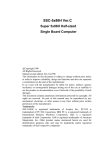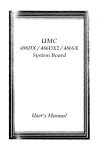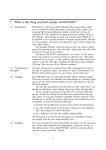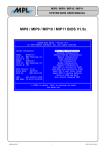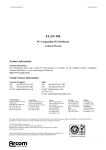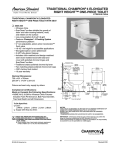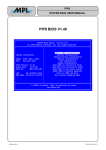Download MICRO COMPUTER SPECIALISTS, INC.
Transcript
IHV-486/5x86 Single Board Computer User's Manual For MCSI PART NO. 88000 IHV-486/5x86 All-In-One Single Board Computers For Industrial/Embedded Systems Applications MICRO COMPUTER SPECIALISTS, INC. "The Embedded PC Specialists" 2598 Fortune Way Vista, CA 92083 U.S.A. Voice (760) 598-2177 - Fax (760) 598-2450 Technical Support BBS (760) 598-2179 Revised April 6, 1999 Revision 1.5 Changes are made periodically to the information contained herein; these changes will be incorporated into new editions of this document. Requests for copies of this publication or the product(s) which it describes should be made to MCSI. While every effort has been made to insure that this document and its accompanying product(s) are free from defects, MCSI, its distributors, representatives, and employees shall not be responsible for any loss of profit or any other commercial damage including, but not limited to, special, incidental, consequential, or other damages occasioned by the use of this product(s). In the event of defect the buyer's sole recourse is to receive a refund or replacement unit at MCSI's discretion if notified within the time period covered by the product warranty. 1996 MCSI Micro Computer Specialists, Inc. All Rights Reserved. PROMDISK is a registered trademark of Micro Computer Specialists, Inc. CARDTRICK is a register trademark of Datalight, Inc. ROM-DOS is a register trademark of Datalight, Inc. IBM is a registered trademark of International Business Machines Corporation. PC/XT & PC/AT are registered trademarks of International Business Machines Corporation MS-DOS is a registered trademark of Microsoft Corporation. All other trademarks are the properties of their respective holders. PREFACE This manual provides information about the MCSI IHV-486/5x86 All-In-One Single Board Computer. This information is intended for users who must implement IBM PC/AT compatible computer solutions to a wide variety of applications which cannot be satisfied using conventional desktop computers. This manual assumes that the reader has a good understanding of MS-DOS and the standard IBM PC/AT compatible architecture. For more information on the IBM PC compatible hardware and software architecture, refer to any of the many books available on the subject. A few suggestions are listed below: •Advanced MS-DOS Programming, Microsoft Press •Programmers Guide to the IBM PC, Microsoft Press •Programming the 80386, Sybex •Undocumented DOS, Addison Wesley INVENTORY CHECKLIST The complete IHV-486/5x86 All-In-One Single Board Computer package consists of the following: IHV-486/5x86 All-In-One Single Board Computer 3½ Diskette containing VGA Video Drivers PROMDISK-Chip Software Utilities with ROM-DOS ver 6.22 (optional) This Manual If any of the above is missing or appears to be damaged, inform MCSI immediately. Table of Contents Section 1 - Introduction___________________________________________________________________ 1 Features .................................................................................................................................................... 1 Section 2 - System Description_____________________________________________________________ 2 Processor .................................................................................................................................................. 2 System Memory (DRAM)....................................................................................................................... 2 Cache Memory ........................................................................................................................................ 3 DMA Controller ...................................................................................................................................... 3 Interrupt Controller ................................................................................................................................ 3 Timers....................................................................................................................................................... 4 Clock/Calendar and CMOS RAM......................................................................................................... 4 Keyboard Port.......................................................................................................................................... 4 Mouse Port............................................................................................................................................... 4 Speaker Port............................................................................................................................................. 4 Reset Switch............................................................................................................................................. 5 Printer Port .............................................................................................................................................. 5 Serial Ports ............................................................................................................................................... 5 Floppy Disk Port ..................................................................................................................................... 5 Enhanced IDE Hard Disk Port ............................................................................................................... 5 Optional PROMDISK-Chip Disk Emulator........................................................................................... 6 SVGA Display Port ................................................................................................................................. 6 WatchDog Timer ..................................................................................................................................... 6 Section 3 - Setup_________________________________________________________________________ 7 Section 4 - Using the PROMDISK-Chip Disk Emulator________________________________________ 8 Using ROM-DOS and Other Disk Operating Systems......................................................................... 8 PROMDISK Low Level Format.............................................................................................................. 8 Section 5 - Installation ____________________________________________________________________ 9 Installing the SIMMs ............................................................................................................................... 9 Installing the CPU ................................................................................................................................... 9 Installing the PROMDISK-Chip ............................................................................................................. 9 Completing the Installation .................................................................................................................... 10 Appendix A - Specifications_______________________________________________________________ 11 Appendix B - Board Outline ______________________________________________________________ 12 Appendix C - Memory and I/O Maps ______________________________________________________ 13 Appendix D - Connectors_________________________________________________________________ 14 Appendix E - Configuration Jumpers_______________________________________________________ 17 Appendix F - BIOS Error Beep Codes ______________________________________________________ 19 SECTION 1 - INTRODUCTION The IHV-486/5x86 All-In-One Single Board Computer (SBC) is a high performance system board that provides the primary elements for building an IBM PC/AT compatible computer for a wide variety of embedded systems applications. The IHV-486/5x86 SBC contains all the basic elements found in a standard IBM PC/AT compatible desktop computer system, plus some unique features which make it ideally suited for industrial applications. The most outstanding features include: an on-board SVGA display controller, a WatchDog timer, an optional PROMDISK-Chip™ Disk Emulator, single +5VDC operation, and a compact half size form factor. The optional PROMDISK disk emulator comes complete with the ROM-DOS version 6.22 operating system, and emulates a bootable hard disk drive with capacities up to 32M-bytes. The WatchDog timer and PROMDISK-Chip makes the board ideally suited for controlling critical processes where unattended operation is essential. The compact half size form factor makes it ideally suited for embedded applications. The IHV-486/5x86 SBC is fully compatible with the IBM PC/AT (ISA Bus) which means virtually all the software written for the IBM PC/AT will run on the IHV-486/5x86 SBC. FEATURES A complete list of features is listed below: • IBM PC/AT Compatible Plug-in Computer • Supports 3.3V/3.45V 486/5x86/DX2/DX4 and AMD/Cyrix Microprocessors to 133Mhz • Super VGA PCI Local Bus Video Controller with 1M-byte Video Memory • ALI Chip Set • AWARD BIOS • Optional PROMDISK-Chip Disk Emulator includes ROM-DOS 6.22 Operating System • Passive Backplane Architecture • 64M-Byte Standard or EDO DRAM System Memory (2-72pin SIMMs) • 128K High Speed Secondary Cache Memory • PS2/AT Compatible Keyboard Port • PS2 Compatible Mouse Port • Two High Speed 16C550 Compatible RS-232 Serial Ports with ±15KV ESD Protection • Multimode Bi-directional Parallel Printer Port • Clock/Calendar with Battery Back-up • Low Power CMOS Design • Half Size AT Plug-in Multilayer Board for Low EMI and High Reliability • WatchDog Timer and Power Monitor • Dual Floppy Disk Port Supports Two 3.5" or 5.25" Drives up to 2.88M-bytes • PCI Extended IDE Hard Disk Port • On-board Mini Speaker • Optional External Reset 1 SECTION 2 - SYSTEM DESCRIPTION The following sections describe the major system features of the IHV-486/5x86 All-In-One Single Board Computer. PROCESSOR The IHV-486/5x86 SBC supports high performance low voltage (3.3/3.45V) 486/5x86/DX2/DX4 microprocessors from 25MHz to 100mhz, and up to 133MHz AMD/Cyrix 5x86 microprocessors. The 486/5x86 microprocessor includes an on-chip 8K-byte unified instruction cache, an 8K-byte data cache, an internal high performance math co-processor, and an enhanced 64-bit data bus. The onboard jumper selectable clock generator makes upgrading to a higher performance CPU easy. Some of the distinctive features of the processors include: • 64-bit External Data Bus • 32-bit Internal Architecture • 128M-byte Directly Addressable Memory Space • Internal 14 Word by 32-bit Register Set • Separate 8K-byte Data and Cache Memories • On-chip Pipelined Floating Point Processor • Integrated Memory Manager SYSTEM MEMORY (DRAM) The IHV-486/5x86 SBC can support up to 64M-bytes of dynamic random access memory (DRAM) organized as two banks of 8Mx72 including eight parity bits. The board will support either standard or high performance EDO DRAM. The memory is configured using two single in-line memory module sockets, which will accept 72-pin single in-line memory modules (SIMMs) organized as 1MB, 2MB, 4MB, 8MB, 16MB, or 32MB with a maximum access time of 70ns. The following table demonstrates some of the most common memory configurations. Typical Memory Configurations Total Memory Bank 0 Bank 1 1M 256Kx36 2M 256Kx36 256Kx36 4M 1Mx36 4M 512Kx36 512Kx36 8M 1Mx36 1Mx36 16M 4Mx36 16M 2Mx36 2Mx36 32M 8Mx36 32M 4Mx36 4Mx36 64M 8Mx36 8Mx36 Bank 0 = SIMM 1 Bank 2= SIMM 2 Note: SIMMs may be installed in either Bank first 2 CACHE MEMORY The IHV-486/5x86 SBC includes 128K-bytes of cache memory for high speed access to blocks of data most recently read from main memory, including buffered data from the disk and video memory. The cache memory will significantly increase system performance over that of a conventional noncached system. DMA CONTROLLER The IHV-486/5x86 SBC memory refresh and DMA functions are included in the System Controller chip which includes the equivalence of two 82C37 DMA controllers. The two DMA controllers are cascaded to provide four DMA channels for transfers to 8-bit peripherals (DMA1) and three channels for transfers to 16-bit peripherals (DMA2). DMA2 Channel 0 provides the cascade interconnection for the two DMA devices thereby maintaining IBM PC/AT compatibility. The DMA channel assignments are listed below: DMA Channel 0: DMA Channel 1: DMA Channel 2: DMA Channel 3: DMA Channel 5: DMA Channel 6: DMA Channel 7: Not Used (8-bit) Alternate for Multi-mode Parallel Port (8-bit) Floppy Disk (8-bit) Multi-mode Parallel Port (8-bit) Not Used (16-bit) Not Used (16-bit) Not Used (16-bit) The DMA request (DRQx) and acknowledge (DACKx/) lines are available on the P1 98-pin edge connector. INTERRUPT CONTROLLER The IHV-486/5x86 SBC has the equivalence of two 82C59A interrupt controllers included in the System Controller chip. The controllers accept requests from peripherals, resolve priorities on pending interrupts and interrupts in service, interrupt the CPU, and provide the vector address of the interrupt service routine. The two interrupt controllers are cascaded in a fashion compatible with the IBM PC/AT. The interrupt priority and assignments are shown below in descending order of priority: Highest IOCHCK/ IRQ0 IRQ1 IRQ8 IRQ9 IRQ10 IRQ11 IRQ12 IRQ13 IRQ14 IRQ15 IRQ3 IRQ4 IRQ5 IRQ6 Lowest IRQ7 Parity Check (Non-maskable) System Timer (Not Available) Keyboard (Not Available) Real Time Clock (Not Available) SVGA Controller Not Used Alternate for Serial Port 2 Alternate for Serial Port 1 Co-processor (Not Available) Not Used Not Used Serial Port 2 Serial Port 1 Alternate for Parallel Port Floppy Disk Controller Parallel Port 3 The interrupt request lines IRQx and IOCHCK/ are available on the 98-pin edge connector except as noted on the previous page. TIMERS The IHV-486/5x86 SBC has the equivalence of an 82C54 Programmable Timer included in the System Controller chip. The 82C54 is a three channel Programmable Counter/Timer chip. The three timers are driven by a 1.19MHz clock source derived from the on-board 14.31818MHz crystal oscillator. The three timers are used as follows: TIMER Channel 0: System Timer TIMER Channel 1: Timer for DRAM refresh TIMER Channel 2: Tone Generation for Audio CLOCK/CALENDAR AND CMOS RAM The IHV-486/5x86 SBC uses a Dallas DS12887 which is the equivalence of an MC146818 real time clock/calendar with 128 bytes of CMOS RAM. An internal lithium battery provides power to the RTC chip for at least ten years when the system power is off. The 128 byte CMOS RAM consists of 14 bytes used by the clock/calendar, and 114 bytes used by the system BIOS. Should your CMOS become corrupted, i.e. loss of battery power or accidentally clobbered, strange errors may occur while attempting to run your programs. Refer to Section 3.0 for instructions on resetting the initial SETUP values. KEYBOARD PORT The IHV-486/5x86 SBC contains an IBM PC/AT compatible keyboard controller for interfacing to a generic IBM PC/AT compatible keyboard. The keyboard controller assembles the serial data from the keyboard into bytes and interrupts the CPU via IRQ1 after each byte is ready to be read. The IRQ1 service routine reads port 60H to get the keyboard scan code and acknowledges by sending a positive pulse to port 61H to clear the interrupt for the next byte. Refer to Appendix D for the keyboard connector location and pin assignments. MOUSE PORT The IHV-486/5x86 SBC contains an IBM PS2 compatible mouse port for interfacing to a generic serial mouse. The mouse port controller assembles the serial data from the mouse into bytes and interrupts the CPU via IRQ1 after each byte is ready to be read. The IRQ1 service routine reads port 60H to get the scan code and acknowledges by sending a positive pulse to port 61H to clear the interrupt for the next byte. Refer to Appendix D for the mouse port connector location and pin assignments. SPEAKER PORT The IHV-486/5x86 SBC contains an on-board sub-miniature audio speaker to provide audio interface to the user. Because of the small size of the speaker, the sound output is much reduced over that of the larger speaker found in most desktop computers. A connector is provided to connect an external 4 speaker if the sound output is not sufficient. Refer to Appendix D for the speaker port connector location and pin assignments. RESET SWITCH The IHV-486/5x86 SBC includes an on-board power detector and power on reset circuit to reset the computer after power is applied, and to hold the computer reset during low power, brown-out conditions. In addition, there are provisions for connecting an external, normally open, push button reset switch. Refer to Appendix D for the reset switch connector location and pin assignments. PRINTER PORT The IHV-486/5x86 SBC contains a multimode parallel port which has the equivalence of an IBM PC/AT Parallel Printer Port. The multimode parallel printer port supports the PS/2 type bidirectional parallel port (SPP), the enhanced parallel port (EPP), and the extended capabilities port (ECP) parallel port modes. The port can be configured as a standard IBM PC/AT compatible LPT1, LPT2, or LPT3 printer port, or disabled completely using the CMOS Setup utility. Refer to Appendix D for the connector location and pin assignments. SERIAL PORTS The IHV-486/5x86 SBC has the equivalence of two NC16C550 UARTs. The two UARTs can be configured as standard IBM PC/AT RS-232C compatible COM1, COM2, COM3, or COM4 serial ports or individually disabled using the CMOS Setup utility. The serial ports use an enhanced RS232 interface chip which provides ±15KV ESD protection. The data rates are independently programmable up to 115.2K baud. Refer to Appendix D for the connector location and pin assignments. FLOPPY DISK PORT The IHV-486/5x86 SBC contains an IBM PC/AT compatible dual floppy disk port with the equivalence of an NEC PD72056B Floppy Disk Controller, an on-chip digital data separator, and an IBM PC/AT compatible floppy disk adapter bus interface circuit. The Floppy Disk Port can be disabled by using the CMOS Setup utility. An on-chip digital data separator provides optimum performance with the following disk drive types: 5.25" 3.5" 5.25" 3.5" 3.5" 360K Double-Sided 720K High Capacity 1.2M High Capacity 1.44M High Density 2.88M High Density Refer to Appendix D for the connector location and pin assignments. ENHANCED IDE HARD DISK PORT The IHV-486/5x86 SBC contains a PCI Extended Integrated Drive Electronics (IDE) Port which directly interfaces to two hard disk drives with embedded controllers. The IDE Disk Port can be disabled using the CMOS Setup utility. Refer to Appendix D for the connector location and pin assignments. 5 OPTIONAL PROMDISK-CHIP DISK EMULATOR The IHV-486/5x86 includes a 32-pin socket designed to accept the MCSI PROMDISK-Chip. The PROMDISK-Chip Disk Emulator is a unique Flash Memory array which emulates a bootable read/write hard disk drive. The PROMDISK-Chip is offered in 4M, 8M, 16, and 32M byte capacities and comes complete with ROM-DOS version 6.22 installed. The PROMDISK-Chip occupies a 32K block of memory space above 640K, whose starting address is selected by jumper JP20. The PROMDISK-Chip uses the Datalight CardTrick® VBF integrated Flash File System and boot utilities. The CardTrick Variable Block Flash (VBF) File System and ROM-DOS allow the PROMDISK-Chip to operate as a non-volatile Read/Write disk drive. This means that you can list directories, copy files, and read and write the Flash memory on PROMDISK-Chip through standard DOS interrupts and commands. SVGA DISPLAY PORT The IHV-486/5x86 SBC includes a Cirrus Logic CL-GD54M40 Super VGA graphic accelorator and display controller which interfaces directly to the local on-board PCI bus. The SVGA display port is fully compatible with IBM VGA, EGA, CGA, and MDA display adapters, and provides improved performance and additional functionality. The board includes 1M-bytes of high speed video SRAM. The SVGA display controller supports the following display resolutions: 1024x768 256 Colors (1M VRAM) 1280x1024 16 Colors (1M VRAM) WATCHDOG TIMER The IHV-486/5x86 SBC includes a WatchDog Timer circuit. The WatchDog Timer ensures that if an application program gets "lost or bombs", the system will reset or a non-maskable interrupt will be issued to the CPU. The WatchDog Timer is enabled by reading I/O port 443H. Once enabled, the WatchDog Timer must be triggered by reading I/O port 443H within the time out period, otherwise the WatchDog Timer will force a hardware reset or activate the IOCHCK/ line, generating a nonmaskable interrupt (NMI). The WatchDog Timer can be disabled by reading I/O port 43H. A jumper is provided to select the time out period and to enable the WatchDog Timer circuit. Refer to Appendix E for the WatchDog Timer configuration jumpers. 6 SECTION 3 - SETUP The IHV-486/5x86 SBC uses the latest AWARD BIOS which contains an internal Setup Utility for configuring the system. The system configuration settings are stored in the on-board CMOS memory which is backed up by a Lithium battery. Should your CMOS become corrupted, i.e. loss of battery power or accidentally clobbered, strange errors may occur while attempting to run your programs. If this occurs select the LOAD BIOS DEFAULTS from the MAIN SETUP MENU or use the Del key. The Setup Utility can be invoked by first causing a cold boot (reset) or a warm boot (Cntrl Alt Del) and pressing the Del key when instructed. This will cause the memory diagnostics to be aborted and the Setup Utility to display the MAIN SETUP MENU. Using the → ↑ ↓ ← cursor keys, move the highlighted bar to the option you wish to modify and then press Enter to select it. When in the MAIN SETUP MENU, the F2 key is used to select the colors used in the setup screens, and the F10 key is used to save the changes before exiting the Setup Utility. The Esc key may be used to exit the Setup Utility without saving the changes. The PgUp and PgDn keys are used to scroll through the selections for a given setting. PgUp is also used to increase the setting and PgDn to decrease the setting. In addition, you may also enter the setup utility directly by pressing the Cntrl Alt Esc simultaneously. After making the desired selections from the various setup menus, you can save your selections by pressing the F10 key or by selecting the appropriate selection from the MAIN SETUP MENU. Notes: 1. The user should be aware that improper selection of certain values in the BIOS FEATURES SETUP UTILITY may cause unpredictable results. If this occurs select the MAIN SETUP MENU and then select the LOAD BIOS DEFAULTS to load the BIOS default values. 7 SECTION 4 - USING THE PROMDISK-CHIP DISK EMULATOR The PROMDISK-Chip Disk Emulator operates as a Read/Write fixed disk drive. The paragraphs that follow describe how to use the optional PROMDISK-Chip. USING ROM-DOS AND OTHER DISK OPERATING SYSTEMS The PROMDISK-Chip has been pre-configured at the factory with the latest version of the Datalight ROM-DOS disk operating system. In addition, a current copy of the operating system is supplied on a floppy diskette. If the operating system is accidentally erased from the PROMDISK-Chip it may be restored using the SYS command. The DOS format utility should not be used to restore the operating system. To change the operating system version or type you should simply use the equivalent DOS SYS command to transfer the operating system. PROMDISK LOW LEVEL FORMAT The Flash memory contained on the PROMDISK-Chip board was initialized with the Datalight CardTrick low level format at the factory. During normal operation the Flash memory should never require reformatting unless there is a serious hardware or software malfunction. In the event it has been determined that the low-level format is corrupted, proceed as follows: 1. At the DOS prompt, run the PROMDISK-Chip low-level format utility PDCFMT.EXE located on the distribution diskette in the PDCHIP subdirectory. 2. Install a bootable floppy diskette in drive A and boot the system. 3. At the DOS prompt type SYS C: to transfer a bootable copy of DOS to PROMDISK-Chip. 4. Remove the floppy diskette from drive A: and reboot the system from PROMDISK-Chip. CAUTION: Do Not use the DOS Fdisk utilities on the PROMDISK-Chip. 8 SECTION 5 - INSTALLATION This section describes the procedures for installing the IHV-486/5x86 All-In-One Single Board Computer into your system. The following is a list of typical peripherals required to build a minimum system: • • • • Passive Backplane and Power Supply IBM PC/AT Type Keyboard Display Monitor Floppy or Hard Disk with MS-DOS, ROM-DOS, or PROMDISK Disk Emulator INSTALLING THE SIMMS When installing or removing the DRAM SIMMs, be sure to first touch a grounded surface to discharge any static electricity from your body. Use the following procedure to install the SIMMs: 1. Insert the first SIMM edge connector at a slight angle into either the SIMM1 or SIMM2 socket. Note that the SIMMs are keyed and will only go in one way. 2. Push the SIMM back into the connector carefully until it snaps into place. 3. Check to make sure the SIMM is inserted securely. 4. If required insert the second SIMM edge connector at a slight angle into the remaining SIMM socket. To remove a SIMM, use a small screw driver to pull back the holding clip on each side of the SIMM and lift the SIMM from the connector. INSTALLING THE CPU When installing or removing the CPU, be sure to first touch a grounded surface to discharge any static electricity from your body. Use the following procedure to install the CPU: 1. Align pin one (white dot or beveled edge) on the CPU chip with pin one of the of the CPU socket. Note pin 1 of the CPU socket is located on the top left corner. To complete the installation gently press the CPU chip into place. 2. Double check the insertion and orientation of the chip before applying power. Improper installation will result in permanent damage to the chip. To remove the CPU chip, insert a small screwdriver between the CPU and the socket and gently pry around the edge until the CPU is released from the socket. INSTALLING THE PROMDISK-CHIP When installing or removing the PROMDISK-Chip, be sure to first touch a grounded surface to discharge any static electricity from your body. Use the following procedure to install the PROMDISK-Chip: 9 1. Align pin one (white dot) on the PROMDISK-Chip with pin one of socket U7 on the CPU board. 2. Push the PROMDISK-Chip into the socket carefully until it is fully seated. 3. Check to make sure the PROMDISK-Chip is installed securely, and there are no bent pins. To remove the PROMDISK-Chip, insert a small screwdriver between the PROMDISK-Chip and the socket and gently pry around the edge until the PROMDISK-Chip is released from the socket. COMPLETING THE INSTALLATION To complete the installation, the following steps should be followed: 1. Set the configuration jumpers in accordance with Appendix E. 2. Install the IHV-486/5x86 SBC into one of the I/O slots in a passive backplane. 3. Connect the applicable I/O cables and peripherals, i.e. floppy disk, IDE hard disk, monitor, keyboard, power supply, etc. 4. Connect an IBM PC compatible keyboard. 5. Turn power on to the display monitor. 6. Turn power on to the backplane power supply. 7. After the BIOS sign-on message is displayed, press the Del key to enter the Setup Utility. 8. Reconfigure the IHV-486/5x86 CMOS using the internal SETUP. 9. Boot the system. 10 APPENDIX A - SPECIFICATIONS This appendix lists the specifications for the IHV-486/5x86 All-In-One Single Board Computer. CPU: Co-processor: Memory: BIOS: Clock/Cal: I/O Bus: DMA: Timers: Interrupts: Reset: I/O Ports: PCI Video Port: PROMDISK Port: Speed: Battery: Benchmark: Size: Weight: Power: Supports: 486/5x86/DX2/DX4 and AMD/Cyrix 5x86 3.3V/3.45V microprocessors, up to 133MHz. Internal to the 486/5x86 Chip System Memory Expandable to 64M-bytes. Supports 512Kx36, 1Mx36, 2Mx36, 4Mx36, or 8Mx36 SIMMs using two 72-pin SIMM sockets. Both standard and high performance EDO DRAM is supported. Internal 8K-byte Data and 8K-byte Instruction Cache Memory. 128K High Speed Cache Memory. AWARD BIOS with Internal SETUP and ROM defaults PC/AT Compatible with internal Lithium battery back-up IBM PC/AT Compatible 98-pin Edge Connector 7 Channels (4 8-bit & 3 16-bit) 3 Programmable 16 Controlled by on-board power detector with provisions for external reset switch at header CN12 2 - RS-232 Serial Ports COM1 at rear connector CN10, and COM2 at header CN6 1 - Parallel Printer Port at header CN5 1 - PS2 Keyboard Port at header CN7 and at rear PS2 type connector CN11 1 - On-board Speaker with Speaker Port at header CN2 1 - Dual 3.5"/5.25" Floppy Disk Port at header CN4 1 - Enhanced IDE Hard Disk Port at header CN1 1 - WatchDog Timer 1 - PS2 Mouse Port at rear connector CN9 1 - PCI SVGA Video Port at rear connector CN8 Chipset: Cirrus Logic CL-GD54M40 VRAM: 1M-byte Resolution: 1024x768 256 Colors, 1280x1024 16 Colors 1- 32pin socket (U7) supports MCSI 4M, 8M, 16M, or 32M PROMDISK-Chip 25-133MHz jumper selectable. Lithium for Clock/Calendar & CMOS RAM (ten years typical) LANDMARK v2.0 =444MHz for 133MHz AMD5x86 P75 Half Size AT board 7.1"L X 4.8"H 12 Oz. +5VDC @ 2.5A 11 12 Bank 0 Bank 0 Denotes Pin 1 1 JP13 JP14 JP10 JP2 JP3 JP4 JP5 CPU Socket CN12 CN3 CN2 CN1 JP15 JP16 JP11 JP9 JP8 JP7 JP6 PROMDISK-Chip U7 JP17 CN4 JP18 JP20 JP19 CN5 CN15 CN6 CN8 CN11 CN10 CN9 CN7 CN13 APPENDIX B - BOARD OUTLINE APPENDIX C - MEMORY AND I/O MAPS The following is the memory map for the IHV-486/5x86 SBC. The addresses are fully PC/AT compatible, unless otherwise specified. IHV-486/5x86 SBC Memory Map Address Used For 00000H - 003FFH Interrupt Vectors 00400H - 005FFH BIOS Values 00600H - 9FFFFH User RAM (DOS) A0000H - AFFFFH Reserved for EGA* B0000H - B7FFFH Video RAM (MDA)* B8000H - BFFFFH Video RAM (CGA)* C0000H - C3FFFH VGA BIOS C4000H - C7FFFH EMS Window C8000H - CFFFFH Reserved D0000H - E7FFFH ROM Scan Devices* E0000H - EFFFFH ROM Scan Devices* F0000H - FFFFFH System BIOS 100000H - 3FFFFFFH User Memory Size 1.0K 0.5K 638.5K 64.0K 32.0K 32.0K 16.0K 16.0K 32.0K 96.0K 64.0K 64.0K 64.0M *External to the IHV-486/5x86 The following is the I/O map for the IHV-486/5x86 SBC. I/O addresses are fully PC/AT compatible, unless otherwise specified. IHV-486/5x86 SBC I/O Map Address Function 000H - 01FH DMA Controller #1 020H - 021H Interrupt Controller #1 022H - 023H Configuration Address Register 040H - 05FH System Timers 060H - 063H Keyboard, Status, & System Control 070H - 07FH Clock/Calendar & CMOS Ram Access 080H - 083H DMA Page Register 0A0H - 0BFH Interrupt Controller #2 0C0H - 0DFH DMA Controller #2 0F0H Clear Math Co-processor Busy 0F1H Reset Math Co-processor 1F0H - 1F8H IDE Hard Disk 278H - 27FH Parallel Printer Port LPT2 2E8H - 2EFH Serial Port COM4 2F8H - 2FFH Serial Port COM2 378H - 37FH Parallel Printer Port LPT1 3BCH - 3BFH Parallel Printer Port LPT3 3E8H - 3EFH Serial Port COM3 3F0H - 3F7H Floppy Disk Controller 3F8H - 3FFH Serial Port COM1 443H WatchDog Timer 13 APPENDIX D - CONNECTORS CN7 Keyboard Header/Connector Pin 1 2 3 4 5 Signal KBCLK KBDATA N/C GND +5VDC CN4 Floppy Disk Port Connector Pin Signal Name 2 RPMLC 4 Not Used 6 Not Used 8 INDEX/ 10 MOTOR0/ 12 DRIVE SELECT1/ 14 DRIVE SELECT0/ 16 MOTOR1/ 18 DIRECTION 20 STEP/ 22 WRITE DATA/ 24 WRITE GATE/ 26 TRACK0/ 28 WRITE PROTECT/ 30 READ DATA/ 32 HEAD SELECT/ 34 DISK CHANGE/ All odd numbered pins are GND CN1 Enhanced IDE Hard Disk Port Connector Pin 1 3 5 7 9 11 13 15 17 19 21 23 25 27 29 31 33 35 37 39 14 Signal IDERST/ IDED7 IDED6 IDED5 IDED4 IDED3 IDED2 IDED1 IDED0 GND Not Used IDEIOW/ IDEIOR/ Not Used Not Used IRQ14 IDESA1 IDESA0 HDCS0/ IDEACT/ Pin 2 4 6 8 10 12 14 16 18 20 22 24 26 28 30 32 34 36 38 40 Signal GND IDED8 IDED9 IDED10 IDED11 IDED12 IDED13 IDED14 IDED15 Not Used GND GND GND IDEALE GND IOCS16/ Not Used IDESA2 HDCS1/ GND CN5 Printer Interface Connector Pin 1 2 3 4 5 6 7 8 9 10 11 12 13 Signal STROBE/ PDAT0 PDAT1 PDAT2 PDAT3 PDAT4 PDAT5 PDAT6 PDAT7 ACK/ BUSY PE SLCT Pin 14 15 16 17 18 19 20 21 22 23 24 25 26 Signal AUTOFD/ ERROR/ INIT/ SLCTIN/ GND GND GND GND GND GND GND GND GND CN10 Serial Port #1 9-pin Sub D Connector Pin 1 2 3 4 5 6 7 8 9 Signal Name CARRIER DETECT #1 RECEIVE DATA #1 TRANSMIT DATA #1 DATA TERMINAL READY #1 GND DATA SET READY #1 REQUEST TO SEND #1 CLEAR TO SEND #1 RING INDICATOR #1 CN6 Serial Port #2 10-pin Header/Connector Pin 1 2 3 4 5 6 7 8 9 10 Signal Name CARRIER DETECT #2 DATA SET READY #2 RECEIVE DATA #2 REQUEST TO SEND #2 TRANSMIT DATA #2 CLEAR TO SEND #2 DATA TERMINAL READY #2 RING INDICATOR #2 GND NOT USED CN11 Keyboard Connector (PS2 type) Pin 1 2 3 4 5 6 Signal KBDATA N/C GND +5VDC KBCLOCK N/C CN12 Reset Header/Connector Pin Signal Name Description 15 1 RESET/ 2 GND Connect to switch, ground this pin to reset Ground CN2 Speaker Port Header/Connector Pin 1 2 3 4 Signal Name SPEAKER N/C GND +5VDC Description Connect to Speaker (-) Ground Connect to Speaker (+) CN3 IDE LED Header/Connector Pin 1 2 Signal Name +5VDC IDE LED Description Connect to IDE LED anode (+) Connect to IDE LED cathode (-) CN9 PS2 Mouse Connector Pin 1 2 3 4 5 6 Signal MSDATA N/C GND +5VDC MSCLK N/C CN13 Auxiliary Power Connector Pin 1 2 Signal Name +5VDC GND CN15 Keylock Header/Connector Pin 1 2 3 4 5 16 Signal Name LED POWER (+) N/C (Key) GND KBLOCK/ GND Description Connect to anode of power LED N/C (Key) Connect to cathode of power LED Connect to ground to inhibit keyboard Ground APPENDIX E - CONFIGURATION JUMPERS JP14 CPU Power Selection Jumper CPU Voltage 3.3VDC 3.45VDC JP14 2-3 1-2 JP2-10 CPU Selection Jumpers CPU Intel 486DX2/DX4 &E AMD 486DX4+ Cyrix 5x86 Intel 486DX2/DX4 &EW SGS ST486DX2V (3.3V) ST486DX4V (3.3V) Cyrix/TI/SGS DX2/DX4 AMD 486DX/DX2/DX4 AMD 5x86-P75 (133) AMD DX2+ (SV8B) JP2 OFF 5-6 JP3 3-4 3-4 JP4 3-4 3-4 JP5 3-4 3-4 JP6 2-3 2-3 JP7 2-3 2-3 JP8 1-2 2-3 JP9 OFF 2-3 JP10 ON ON 1-2 OFF 5-6 OFF 5-6 OFF 5-6 1-2 2-3 2-3 2-3 2-3 1-2 1-2 1-2 OFF ON OFF 1-3 5-6 3-4 3-4 3-4 2-3 2-3 2-3 2-3 ON JP11 AMD DX4 (SV8B) Cache Control Jumper OFF ON Write Back Internal Cache Write Thru Internal Cache JP13, JP15, & JP16 CPU Clock Speed Selection Jumpers CPU Clock 25MHz 33MHz 40MHz JP13 OFF OFF ON JP15 1-2 1-2 2-3 JP16 OFF 1-2 3-4 3-4 Note: DX2/DX4-100 & 5x86-100 use 33MHz CPU Clock DX2-80/DX4-120 & 5x86-120 use 40MHz CPU clock AMD 5x86-133 use 33MHz CPU clock JP18 PS/2 Mouse Enable Jumper ON OFF Enabled, IRQ12 (Default) Disabled 17 JP19 WatchDog Timer Control Jumper 1-2 2-3 OFF Generates hardware RESET when time out occurs. (Default) Generates NMI (IOCHRDY) when time out occurs. Disable JP17 WatchDog Timer Time-out Period Jumper Time 1second 2 seconds 10 (Default) 20 seconds 110 seconds 220 seconds 1-2 OFF OFF OFF OFF ON ON 3-4 OFF OFF ON ON OFF OFF 5-6 ON ON OFF OFF OFF OFF 7-8 OFF ON OFF ON OFF ON JP20 PROMDISK-Chip Address Selection Jumper Address Segment D000H D800H E000H Special Do Not Use 18 JP20 1-2 3-4 5-6 7-8 APPENDIX F - BIOS ERROR BEEP CODES During the POST (Power On Self Test) routines, which are performed each time the system is powered on, errors may occur. Nonfatal errors are those which, in most cases, allow the system to continue the boot up process. The error messages normally appear on the screen. Fatal errors are those which will not allow the system to continue the boot-up procedure. If a fatal error occurs, you should consult with MCSI Customer Service for possible repairs. These fatal errors are communicated through a series of audible beeps. The numbers on the fatal error list below correspond to the number of beeps for the corresponding error. All errors listed, with the exception of number eight, are fatal errors. No. of Beeps Error Message 1 Refresh Failure - The memory refresh circuitry is faulty. 2 Parity Error - A parity error was detected in the first 64K block of system memory. 3 Base 64KB Memory Failure - A memory failure occurred within the first 64KB of memory. 4 Timer Not Operational - Timer #1 has failed to function properly. 5 Processor Error - The CPU chip has generated an error. 6 8042-Gate A20 Failure - The keyboard controller (8042) contains the Gate A20 switch which allows the CPU to operate in virtual mode. This error message means that the BlOS is not able to switch the CPU into protected mode. 7 Processor Exception lnterrupt Error - The CPU chip has generated an exception interrupt. 8 Display Memory Read /Write Error - The video adapter is either missing or the video memory is faulty. PLEASE NOTE: This is not a fatal error. 9 ROM Checksum Error - The ROM checksum value does not match the value encoded in the BIOS. 10 CMOS Shutdown Register Read/Write Error - The shutdown register for the CMOS memory has failed. 11 Cache Memory Read/Write Error - A Cache Memory failure occurred, do not enable the Cache Memory to resume operation.. 19




























